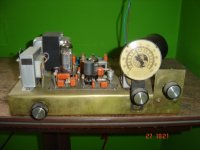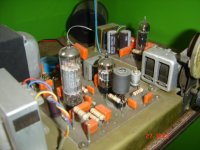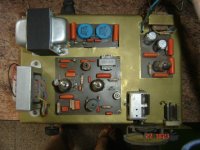Thanks!
Inside
Inside
An externally hosted image should be here but it was not working when we last tested it.
Last edited:
Thanks!Incredible finishing! Which is the loudspeaker?
Best Regards
Loudspeaker - Tannoy Turnberry SE
Looks superbly!
Chassis made yourself?
This is my Simple SE (Tubelab PCB) with Gold Lion reissue KT88's and 12AT7 driver... Edcor transformers. I had the front bezel lasered at work.
Very cool!
Hmm, this may be off topic but I can't help wondering what's going on here. I have noticed that people who build George's amps generally (almost all of them) take good pictures of their amps. When I say good pictures I mean kinda artistic pics. I find this interesting and curious. And not only the pictures, chassis are also above average build quality. There must be a reason behind this but I can't quite figure it out.
We need to try to do well. Bad it itself out.
Hi from Russia!
my first tube amplifier
An externally hosted image should be here but it was not working when we last tested it.
Fundamentally!
In the truest sense of the word.
ovpopov65
Very nice.And here is the granite preamp..... :
:
http://www.diyaudio.com/forums/solid-state/96192-post-your-solid-state-pics-here-57.html#post1650279
Ancient Audio was the inspiration.....
Very nice.And here is the granite preamp.....
http://www.diyaudio.com/forums/solid-state/96192-post-your-solid-state-pics-here-57.html#post1650279
Ancient Audio was the inspiration.....
Yes...it could be corian.Mine is granite and probabily I'll never do that again...
https://picasaweb.google.com/115586837612433686520/MyPreamp#
https://picasaweb.google.com/115586837612433686520/MyPreamp#
It's not a real stone...NOS2005 - congrats, an AWESOME job. Very nice. How is the chassis made? Is it some kind of veneer on the board frame? Its not a real stone as i understand, right?
You are absolutely right!.. could also be Corian .. with granite look ...
I have used in this project CORIAN
Last edited:
@NOS2005: Excellent build. I have OPTs and tubes for a 6C33C but a few amps to finish before I can start. Monoblocks on granite? Why not. Neat job mate! Do you have a schematic? Driver tubes is?
Thanks!
Schematic - _http://altor.sytes.net/Site_gif/af33_1.pdf
Driver - 6g5p
ovpopov65
Very nice.And here is the granite preamp.....:
http://www.diyaudio.com/forums/solid-state/96192-post-your-solid-state-pics-here-57.html#post1650279
Ancient Audio was the inspiration.....
Very nice! Good job!
I use it in the next project.
My Tube Regenerative AM receiver
There are some photos of my brass chassis, brass variable capacitors, regenerative broadcasting receiver, 3 tubes: ECL85 pre and audio output, NFB and ultralinear wired, ECF801 (from TV tuner), pentode as RF amplifier and decoupler, and 6X4 rectifier. Power (rear black core and aluminium), and output (in front of the second photo) transformers are home-made, as all coils (including filter choke, back of the supply board). All caps, except the electrolytics are Siemens MAC autoregenerable, and electrolytics are Nichicon 105ºC. Ferrite antenna. The dial is recovered from old radio, also brass made, and has been several years in the junk box. Note the board with a double line filter to prevent line noise, and the wire almost all under chassis.
From left to right, volume control plus power switch, tuning and "throttle" capacitor, (Regen control). The main tuning coil is the black (ferrite covered) at first plane in photo 2. I have the circuit in pure DOS ASCII characters (in Spanish) with trafos and coil calculations.
There are some photos of my brass chassis, brass variable capacitors, regenerative broadcasting receiver, 3 tubes: ECL85 pre and audio output, NFB and ultralinear wired, ECF801 (from TV tuner), pentode as RF amplifier and decoupler, and 6X4 rectifier. Power (rear black core and aluminium), and output (in front of the second photo) transformers are home-made, as all coils (including filter choke, back of the supply board). All caps, except the electrolytics are Siemens MAC autoregenerable, and electrolytics are Nichicon 105ºC. Ferrite antenna. The dial is recovered from old radio, also brass made, and has been several years in the junk box. Note the board with a double line filter to prevent line noise, and the wire almost all under chassis.
From left to right, volume control plus power switch, tuning and "throttle" capacitor, (Regen control). The main tuning coil is the black (ferrite covered) at first plane in photo 2. I have the circuit in pure DOS ASCII characters (in Spanish) with trafos and coil calculations.
Attachments
Awesome. I love the thermometer tuning dial.
Thanks. It is from a (Perhaps) 1920-30´s radio.
Sorry - 6e5pDriver - 6g5p
it's right!
- Home
- Amplifiers
- Tubes / Valves
- Photo Gallery


